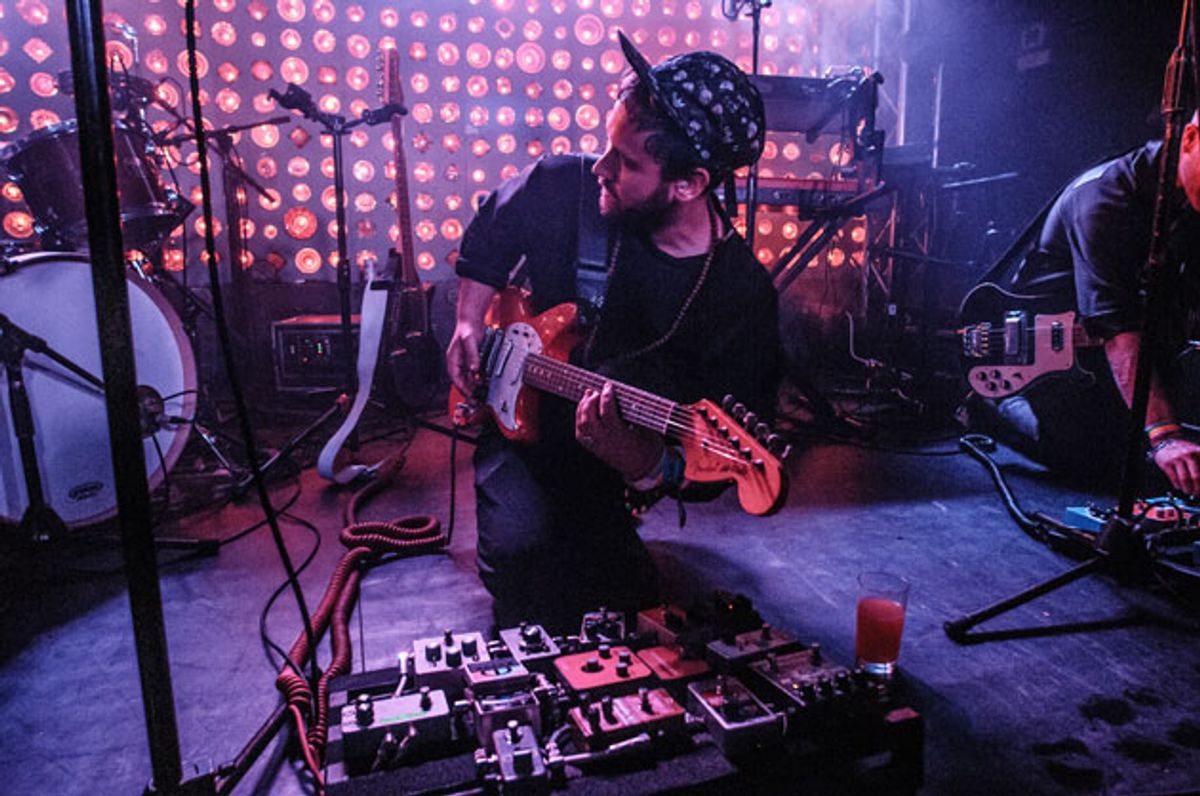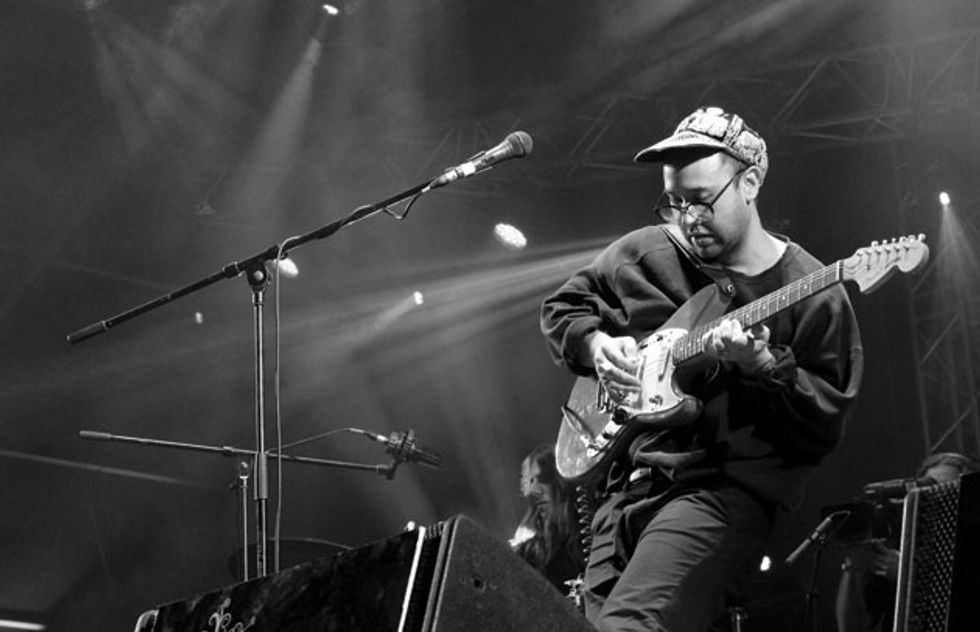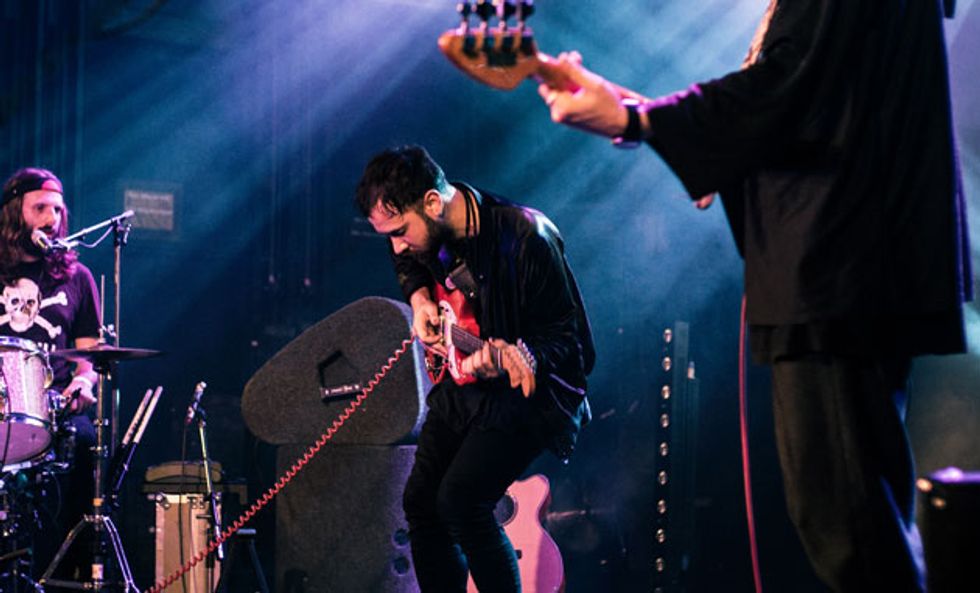This tinkering guitarist’s philosophy is to sound unique by building his own gear.
In 2010, ex-Mint Chicks guitarist Ruban Nielson posted new music online under the moniker “Unknown Mortal Orchestra.” He didn’t know what to expect. After years fronting the somewhat-punk Mint Chicks, Nielson, a New Zealand native, relocated to Portland, Oregon, and worked nine-to-five. Music making was something he did at night after work as a hobby.
That changed fast.
Nielson’s oozy, swirling, psychedelic-fuzz-meets-subtle-yet-infectious-grooves were well received by an alternative music world hungry for, well, alternatives. He assembled a band, signed a record deal, and hit the road. Five years and three records later, Nielson alternates between months of solitude—holed up in his basement tinkering, tweaking, recording, looping, and arranging—and playing sold-out shows across several continents.
Unknown Mortal Orchestra’s music is built around Nielson’s idiosyncratic yet formidable guitar playing. Armed with a Fender Jag-Stang, a Rogue Electric Sitar Guitar, and an ever-evolving collection of boutique and personally handmade effects, he conjures up diverse, otherworldly tones and employs an unorthodox fingerstyle approach. “The music I was playing was more arpeggiated and less about straightforward block chords,” he says. “It just made sense to drop the pick altogether.”
UMO tours as a quartet. In addition to Nielson on guitar and vocals, it features Jacob Portrait on bass, Riley Geare on drums, and Quincy McCrary on keys. But don’t expect to see a strict recreation of the album in concert: Nielson considers the studio and stage to be different animals. “Once we understand what makes the songs tick, then we go pretty nuts,” he offers. “Some songs we completely open up. I like the idea of not knowing exactly what we’re going to play onstage.”
Nielson spoke with PG on the phone from Minneapolis about UMO’s new album, Multi-Love, some of his earliest influences, why he rebuilds his pedals, his high-end lo-fi recording methods, and other adventures in the kingdom of guitar.
When did you start playing the guitar?
My dad was into drugs in my childhood and then he got sober. One of the steps [to sobriety] is to make amends to the people you love. One of the things he did was get me a guitar. I was in college already—in art school—and music turned into my hobby.
I read that your father is a musician. Did you have music around the house? Where did you learn about theory and harmony?
I still don’t really know much about theory and harmony. I know enough to write my songs—that’s about it. But my dad was a composition major and he explains to me what I’m doing in my own songs half the time [laughs].
That’s interesting because your music is more complex than your typical rock song—you have more advanced chords and interesting chord motion going on.
I didn’t start playing guitar until after I left high school, but my dad exposed me to a lot—like Miles Davis, Coltrane, and fusion. I grew up around Steely Dan and all that stuff. I feel that my ear was more developed than my ability to write music. I don’t necessarily know what the voicings are called that I’m using a lot of the time, but I’m hearing them that way in my head. Sometimes it just takes me a while to figure out what it is that I’m hearing.
I hear a lot of ’80s R&B in your songs—Fine Young Cannibals, Terence Trent D’Arby, Prince. Do you listen to any of that?
Yeah, sure. Terence Trent D’Arby is someone I listen to. Prince, of course—I’m pretty obsessed with Prince. Michael Jackson was a big influence on the last record—Off the Wall was pretty important. I was a little kid in the ’80s and a lot of that stuff seeps into my subconscious. When I was a kid my dad put a big Chaka Khan poster on the wall, so I was growing up around that kind of music—Sheila E., the Time, DeBarge.
I also hear a huge Beatles influence on Multi-Love, especially your song “Stage or Screen.”
I’ve gotten to a point with the Beatles where I’ve read every single book and listened to the albums so many times that I have to take a break from them for a little while. A lot of songs I write start off sounding like the Beatles and then I move them somewhere else. On this album, “Stage or Screen” is the most obvious Beatles-sounding song.
While recording Multi-Love I was more influenced by Bowie’s sonic stuff from the ’70s—that whole period between Young Americans and Scary Monsters—the [Tony] Visconti era. Sonically I was thinking along those lines, but I also wanted to use a little bit of digital outboard gear, like digital delays and pitch shifters.
Do you own any of that gear?
I wanted to get an Eventide Harmonizer I found on eBay, but I couldn’t win it. So I found this Lexicon processor—it’s not a digital delay, it’s more like a multi-effects unit—and I use that a lot on the record. I like the sound of it and it was the next best thing I could get to an Eventide Harmonizer. It was cool to use something I’d never really heard of before that could get similar effects.
When a friend gave Nielson (a former Telecaster player) a Jag-Stang, he decided to tune it down a half-step à la Hendrix. It’s been his main guitar ever since. Photo by Raquel Candeias.
What’s your approach to working with effects?
I’m usually reacting to something sonic. I got the [Catalinbread] Pareidolia a couple of years ago—it’s kind of a Uni-Vibe effect—it just sounds so good. There are so many riffs and things that I play just by jamming around with it. I’m pursuing things all the time. If I find a pedal I like, I use it for a long time and then I try to build a clone to see if I can improve on it. I sit around in my basement tweaking it plugged in—on the breadboard—and changing out different components and adjusting the trim until I get everything just exactly how I want it.
How do you know what you’re doing?
I just started tinkering. I started trying to fix my guitars so I wouldn’t have to wait for a tech to get them back to me. I started to tear my guitars apart when something went wrong and I would give them to the tech after I messed them up. Eventually I just got to the point where things were working, my soldering was happening, and I could fix them myself. I went from that to pedals and some outboard gear, and now it’s kind of my hobby.
building your sound.”
You have a few no-name, unmarked pedals on your board. Did you build them?
Yeah. I had a Fulltone Octafuzz, which is a really amazing pedal, but I had this idea that I might be able to make my own that was a little more unique. So I built that. I built a Green Ringer and a Foxx Tone Machine—I mean more or less based on the circuit. I can put carbon comp resistors in and use my own combination of transistors until I find something that is exactly the same. I like the idea that instead of buying your sound, you’re building your sound. A lot of kids take photos of my pedalboard, too, so it’s cool to a have a few that are just blank metal boxes that the kids theorize about.
Do you follow any rules in terms of pedal placement?
I’m always moving things around. I’ve got an Analog Man Bi-CompROSSor that I’ve had at the beginning of the chain and at the end of the chain. At the moment I have it at the end. It’s nice to have a compressor at the end of everything—especially with a phaser pedal, which has frequency spikes. It’s nice to control them.
Ruban Nielson's Gear
Guitars
Fender Jag-Stang
Rogue Electric Sitar Guitar
Amps
Fender Hot Rod DeVille
Orange AD30 head
Effects
Analog Man Bi-CompROSSor
Electro-Harmonix Nano Small Stone Phaser
Catalinbread Pareidolia
TC Electronic Ditto Looper
Electro-Harmonix Freeze
Soundblox Envelope Filter
Boss Chromatic Tuner
Catalinbread Belle Epoch (EP3 Tape Echo Emulation)
Catalinbread Topanga Spring Reverb
Electro-Harmonix Memory Toy
Two homemade mystery boxes
Strings and Picks
D’Addario NYXL (.010–.046)
Are you using your amp or pedals for distortion?
I’m using my amp—I like amp drive. I usually push the front end pretty hard but the actual volume will be pretty mellow. Not super quiet, but on 3 or something like that. Onstage I’m pretty quiet. I have my amp shooting at me from the side—I don’t put it behind me. I don’t want my amp to be shooting down my microphone. I have a 500 series compression and distortion on my mic so I need to keep that as clean as possible. So I keep my amp on the side and Jake [Portrait], the bass player in my band, has his amp on the other side of the stage. Both amps are on the side pointing in, rather than pointing at the crowd from the back.
Are you using your amp as your onstage monitor?
Yes and that helps. I don’t like hearing my guitar in my monitor because there’s no telling what kind of crappy stuff they have. I only get my vocals through the monitor. Lately I’ve been trying to phase out my vocal in the monitor and have no monitors at all.
How do you hear yourself?
I have an earplug. I might move to in-ears, but right now I’m just using an earplug and have the monitors really, really quiet. I can hear my pitch better when I have an earplug in.
How many amps do you have onstage?
Just one. I went through a phase where I modded my Fender DeVille so one of the speakers could be plugged in from another amp and the Deville ran only one of its speakers. I would have my Orange AD30 running the second speaker. That’s my ideal setup, but it’s a hassle to do that every night. At the moment I just take the Deville on tour.
What do you like about your main guitar, the Fender Jag-Stang?
It was just this funny guitar my friend gave me. When I started on the UMO stuff I pulled it out. It would never stay in tune and sounded really strange, but when I plugged it into a Blues Junior, I started to come up with completely different ideas. I tuned it a half-step down and started playing with my fingers. It was just a whole new style that emerged in the space of about two weeks after messing with this guitar. The neck is really perfect. When I tuned a half-step down—which I just did because Jimi Hendrix did it and I thought if I was going to start writing some new music this was my chance to start messing with that—that loosened the strings up. The neck was a smaller scale so it gave me the ability to do completely different things. I was able to get around the neck a lot easier—more comfortably than I ever had with a Telecaster. I’ve tried to upgrade my guitar and I always come back to the Jag-Stang. It has a lot of personality.
Ruban Nielson plays his Fender Jag-Stang with his band Unknown Mortal Orchestra at the Tivoli music venue in Utrecht, Netherlands, circa November 2013. Photo by Justin de Nooijer.
Does it have a Mustang-style whammy on it?
It does, but I never really use it. I have it there because I used to do wobbly stuff. But one of my favorite guitarists is Bill Frisell, and I’ve always really loved the way that he would mess with the neck and bend it out of tune. I do that a lot. A big part of my chord playing is that wonky sound I lifted from him.
It looks like you replaced the humbucker with a single-coil in the bridge position.
The Jag-Stang was a little too noisy for me, so I put Lace Sensor Golds in the bridge and neck positions because they’re good at noise canceling. And they sound really awesome.
How do you go about getting good vocal sounds and recording drums?
I just experiment with it. I didn’t go to engineering school—all I have to go on is making records. I try to keep it simple. I usually use two mics. In fact, all drums on all my records never have more than two mics. I use one mic as the main sound—usually placed somewhere in the middle between the kick drum and the snare—and then use the second mic to get definition in the kick drum.
I discovered you can get much better drum sounds with less microphones. There are so many phase issues. Phase is such an important part of recording and if you have six microphones or more, it can be a phase nightmare. You have too many things. I find that with guitar, too. Sometimes I try to record the guitar with stereo mics, but I don’t think it’s worth it. Just throw a mic up and make sure the part is cool. That’s more fun for me.
So you just record it and then tweak it later?
Yeah. I’ll send it out to different outboard gear, like reamping. I have some compressors now that I use and I run things through pedals. I have no problem running a drum track through a Mu-Tron Phasor or whatever. I’ll put it through anything—a cheap piece of gear or something nice that I have. I try things out and I keep working on the sound until it’s awesome to me.
Do you keep a log in case you want to go back to something you had?
I try to keep to the philosophy that I have to move forward. I do keep insurance—I have all my files saved as I go. But I never find that I go back to things. It forces you to make the decision about what is cool. I think it is really important to make those decisions. You have to decide whether that guitar sound is cool and if you’re going to keep it forever or not. A problem with having options is that it gives you an excuse to not make stylistic choices. And that’s what it is all about—deciding what you think is cool and then going with it forever. All the great records were made like that.
YouTube It
Dig the righteous solo starting at 3:16 and how Nielson uses his index finger as a pick. Listen for the insane tones on the song’s fade out, too.
Did you develop your aesthetic sense through listening or by trial and error?
I was in a band with my brother earlier and we made our own recordings, so I learned a lot. But we were really opinionated music fans before we ever started making records. I had really strong ideas about what I thought was cool and what I thought was lame before I ever started thinking I could make records myself. I think that really helped—having conversations about that stuff already. Then it was just a case of, “Oh, I want to get that clapping sound like On the Corner.” Then it’s years of trying to figure out what it is that makes that sound so fat and so good. We started on Pro Tools, and I remember trying to record hand claps was such a big thing. You put a microphone up and record it, and you’re like, “Why doesn’t it sound like a real hand clap?” You don’t realize until later that you need a real fat preamp to get that sound. “What’s a preamp?” “Why does something sound a certain way?” “Oh, it’s because they recorded it to tape.” It’s that process of learning and thinking that is so much fun.
Ruban’s Lunchbox
Ruban Nielson travels with a 500 series rack—or “lunchbox” in studio parlance—full of goodies. It’s a compact, rugged box with a handle that’s stocked with preamps, compressors, and other devices to enhance or color your sound. API (Automated Processes Incorporated) built the original lunchboxes in the late ’70s to house their 500 series modules. (API owns the name “Lunchbox.”) Over the years the format was standardized. Today, many companies make modules that conform to 500 series specs.Nielson’s lunchbox houses a number of preamps (an essential tool that boosts a relatively weak microphone signal), including a high-end Neve preamp and an Avedis MA5. He has signal-processing units like a BAC-500 compressor and a Radial Tank Driver Spring Reverb Interface. “I have a real spring reverb rackmounted underneath the 500 series rack,” he says. He also uses a number of DIY RE Colour Series modules. “It comes as a kit and you put different cards in it. I have a slight delay card, a tube saturation card, and Cinemag Output Transformer—three different kinds of color that sound cool to me.”
The 500 series is a popular format for capturing great tones. On the road, Nielson uses his 500 series modules primarily for vocals. “When I’m off the mic a little, it’s really clean,” he says. “It breaks up and gets crazy when I get really close. When I cup the mic it sounds lo-fi and cool. I can control a lot of what’s going on just with my mic technique. I can sing clean or distorted and it’s really fun.”




